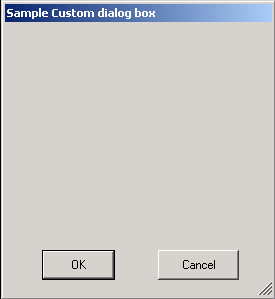Form as Dialog example

Imports System
Imports System.Collections
Imports System.Data
Imports System.IO
Imports System.Xml.Serialization
Imports System.Windows.Forms
Imports System.Drawing
Imports System.Drawing.Drawing2D
Imports System.Drawing.Text
Imports System.Drawing.Printing
Public Class MainClass
Shared Sub Main()
Dim myForm As New Form1()
If myForm.ShowDialog() = DialogResult.Cancel Then
MessageBox.Show("You pressed the cancel button")
Else
MessageBox.Show("You pressed OK.")
End If
End Sub
End Class
Public Class Form1
Inherits System.Windows.Forms.Form
#Region " Windows Form Designer generated code "
Public Sub New()
MyBase.New()
'This call is required by the Windows Form Designer.
InitializeComponent()
'Add any initialization after the InitializeComponent() call
End Sub
'Form overrides dispose to clean up the component list.
Protected Overloads Overrides Sub Dispose(ByVal disposing As Boolean)
If disposing Then
If Not (components Is Nothing) Then
components.Dispose()
End If
End If
MyBase.Dispose(disposing)
End Sub
Friend WithEvents btnOK As System.Windows.Forms.Button
Friend WithEvents btnCancel As System.Windows.Forms.Button
Friend WithEvents PictureBox1 As System.Windows.Forms.PictureBox
'Required by the Windows Form Designer
Private components As System.ComponentModel.Container
'NOTE: The following procedure is required by the Windows Form Designer
'It can be modified using the Windows Form Designer.
'Do not modify it using the code editor.
<System.Diagnostics.DebuggerStepThrough()> Private Sub InitializeComponent()
Me.PictureBox1 = New System.Windows.Forms.PictureBox()
Me.btnCancel = New System.Windows.Forms.Button()
Me.btnOK = New System.Windows.Forms.Button()
Me.SuspendLayout()
'
'PictureBox1
'
Me.PictureBox1.Anchor = ((System.Windows.Forms.AnchorStyles.Top Or System.Windows.Forms.AnchorStyles.Left) _
Or System.Windows.Forms.AnchorStyles.Right)
Me.PictureBox1.Location = New System.Drawing.Point(0, 8)
Me.PictureBox1.Name = "PictureBox1"
Me.PictureBox1.Size = New System.Drawing.Size(288, 184)
Me.PictureBox1.SizeMode = System.Windows.Forms.PictureBoxSizeMode.StretchImage
Me.PictureBox1.TabIndex = 2
Me.PictureBox1.TabStop = False
'
'btnCancel
'
Me.btnCancel.Anchor = System.Windows.Forms.AnchorStyles.Bottom
Me.btnCancel.DialogResult = System.Windows.Forms.DialogResult.Cancel
Me.btnCancel.Location = New System.Drawing.Point(168, 240)
Me.btnCancel.Name = "btnCancel"
Me.btnCancel.Size = New System.Drawing.Size(88, 32)
Me.btnCancel.TabIndex = 1
Me.btnCancel.Text = "Cancel"
'
'btnOK
'
Me.btnOK.Anchor = System.Windows.Forms.AnchorStyles.Bottom
Me.btnOK.DialogResult = System.Windows.Forms.DialogResult.OK
Me.btnOK.Location = New System.Drawing.Point(40, 240)
Me.btnOK.Name = "btnOK"
Me.btnOK.Size = New System.Drawing.Size(80, 32)
Me.btnOK.TabIndex = 0
Me.btnOK.Text = "OK"
'
'Form1
'
Me.AutoScaleBaseSize = New System.Drawing.Size(6, 15)
Me.ClientSize = New System.Drawing.Size(292, 288)
Me.ControlBox = False
Me.Controls.AddRange(New System.Windows.Forms.Control() {Me.PictureBox1, Me.btnCancel, Me.btnOK})
Me.MaximizeBox = False
Me.MinimizeBox = False
Me.Name = "Form1"
Me.Text = "Sample Custom dialog box"
Me.ResumeLayout(False)
End Sub
#End Region
Private Sub Form1_Load(ByVal sender As System.Object, ByVal e As System.EventArgs) Handles MyBase.Load
Me.Visible = False
Me.AcceptButton = btnOK
Me.CancelButton = btnCancel
End Sub
End Class
Related examples in the same category